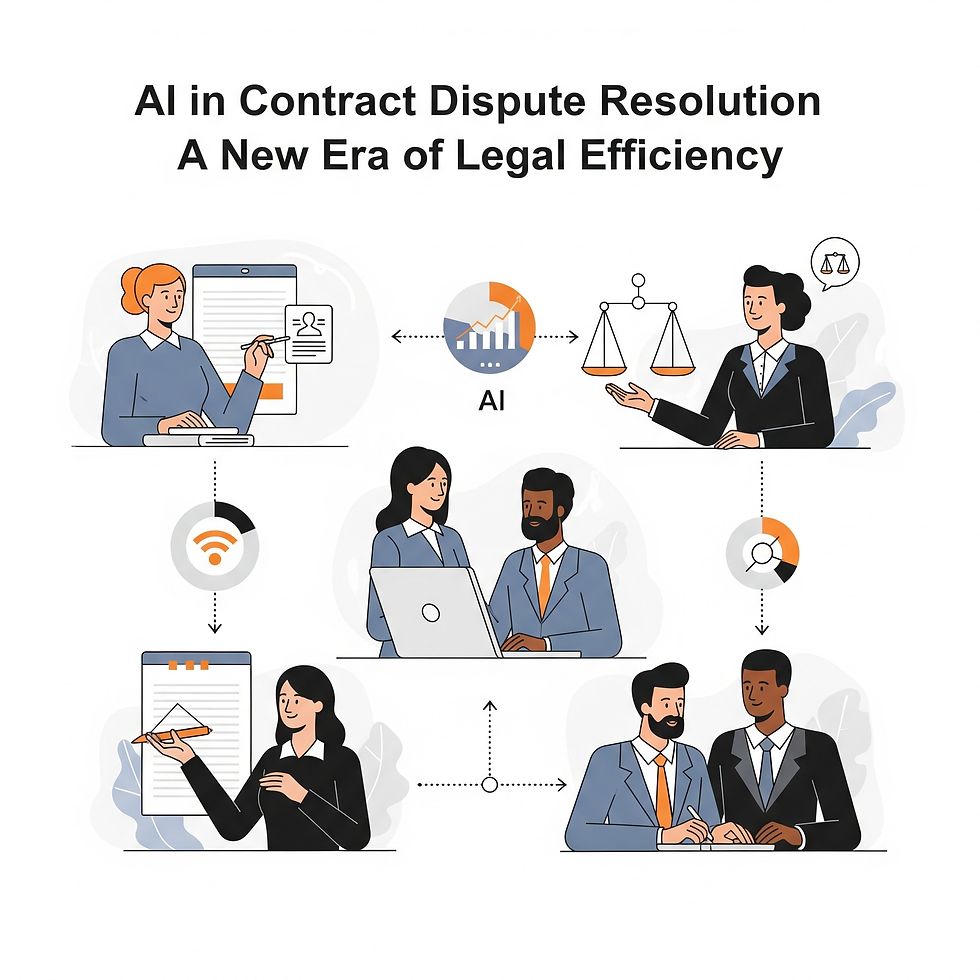AI in Contract Dispute Resolution: A New Era of Legal Efficiency
- Legal Amenity

- Jul 7
- 4 min read
The traditional methods of resolving contractual disputes—litigation, arbitration, and mediation—are often time-consuming, costly, and complex. As global commerce accelerates and digital transactions grow, the legal system is increasingly turning to Artificial Intelligence (AI) to enhance contract dispute resolution.
AI is no longer confined to predictive text and chatbots—it is now being leveraged to analyze legal documents, forecast outcomes, suggest settlements, and even assist in arbitration processes. While still in its evolutionary stage, the integration of AI into dispute resolution mechanisms is transforming the way legal professionals and businesses approach conflicts.

What Is AI in Contract Dispute Resolution?
AI in dispute resolution refers to the use of intelligent algorithms and machine learning tools to:
Analyze contractual disputes
Identify legal issues
Assess risks and outcomes
Provide recommendations
Assist or automate aspects of negotiation or arbitration
These systems are typically powered by Natural Language Processing (NLP) and Machine Learning (ML) models that process historical case data, legal precedents, and contract terms to generate insights.
Key Applications of AI in Dispute Resolution
1. Predictive Analytics and Risk Assessment
AI tools can scan previous judgments and arbitration awards to predict the likely outcome of a contractual dispute. This empowers lawyers and businesses to:
Assess litigation risk
Make informed decisions about settlement
Avoid unnecessary legal costs
Example: Platforms like Lex Machina and Premonition provide litigation outcome predictions based on judge history, case types, and jurisdictional trends.
2. Automated Legal Research
AI can rapidly analyze volumes of legal documents, case laws, and statutes to identify relevant precedents and strengthen legal arguments in contract disputes. This accelerates case preparation and enhances legal accuracy.
3. AI-Assisted Mediation and Online Dispute Resolution (ODR)
Several platforms now offer AI-driven mediation where parties resolve disputes online with limited or no human intervention. AI systems can suggest compromise solutions, flag unfair terms, and facilitate communication between parties.
Example: ODR platforms like Modria and Matterhorn use AI to help resolve commercial, consumer, and contractual disputes digitally.
4. Clause Interpretation and Contract Analysis
AI can extract and interpret key clauses from contracts (e.g., indemnity, termination, force majeure) to assess potential breach and applicable remedies. This is particularly useful in cross-border or complex commercial contracts where language and legal standards vary.
5. Smart Contract Disputes
With the rise of blockchain-based smart contracts, AI tools are being developed to monitor compliance and resolve performance-related issues automatically. These tools can detect when a party has failed to meet a pre-coded obligation and initiate dispute mechanisms.
Benefits of Using AI in Contractual Dispute Resolution
1. Speed and Efficiency
AI tools can perform in minutes what would take legal teams days or weeks—leading to faster dispute resolution and reduced backlogs.
2. Cost Reduction
By automating repetitive tasks (document review, legal research, clause analysis), AI reduces dependence on extensive legal manpower and associated fees.
3. Consistency and Objectivity
AI provides data-driven outcomes based on legal precedents, reducing the influence of human bias or emotion—especially in mediation or negotiations.
4. Accessibility
ODR platforms powered by AI make dispute resolution more accessible to individuals and SMEs that cannot afford traditional legal services.
5. Early Dispute Detection
AI tools integrated into contract lifecycle management (CLM) systems can flag potential breach risks early, allowing for pre-dispute interventions.
Limitations and Legal Concerns
1. Lack of Human Judgment
AI cannot replicate human intuition, empathy, or contextual understanding—essential in resolving emotionally charged or complex disputes.
2. Accountability and Liability
Who is responsible if an AI tool provides a flawed recommendation that leads to loss or injustice? Legal clarity on AI liability is still evolving.
3. Data Privacy Risks
AI systems require access to sensitive contractual and legal data. Without robust cybersecurity and compliance with data protection laws (e.g., India's DPDP Act or EU GDPR), privacy risks can arise.
4. Bias in AI Systems
If AI is trained on biased legal data (e.g., judgments with systemic unfairness), it can reinforce and replicate discriminatory patterns.
5. Admissibility and Credibility
In courts or arbitration, the legal community may question the credibility of AI-derived predictions or interpretations unless there is transparency in the AI’s decision-making process.
Indian Legal Landscape: AI in ADR and Court Systems
India is gradually exploring AI integration in its judicial and quasi-judicial systems. Initiatives include:
SUPACE (Supreme Court Portal for Assistance in Court Efficiency): AI tool launched by the Supreme Court of India to assist judges in case research.
E-Courts Mission Mode Project: Aims to digitize and automate Indian court proceedings.
While full-scale AI-based dispute resolution is still in early stages, ODR platforms like Presolv360 and CADRE are emerging as leaders in tech-enabled contract dispute resolution in India.
However, India lacks specific legislation on AI in legal processes. Future regulation may need to address:
AI accountability
Ethical guidelines for AI in ADR
Standardization of AI use in contract enforcement
Future Outlook
The future of AI in contract dispute resolution is collaborative, not replacement-based. AI will serve as a co-pilot for legal professionals, enhancing their capabilities while leaving final judgments to humans.
Expected trends include:
Greater use of AI in arbitration and mediation
Increased adoption of smart contract enforcement tools
Integration of AI in internal dispute resolution mechanisms in corporations
Development of AI ethical and regulatory frameworks
Conclusion
AI holds the potential to transform contract dispute resolution by making it faster, fairer, and more cost-effective. While it cannot replace the nuanced judgment of a trained lawyer or mediator, it can significantly enhance their efficiency and strategic insight.
Legal professionals must embrace AI with a mindset of augmentation, not automation—ensuring they harness its capabilities while preserving ethical standards, legal integrity, and human oversight.
As the intersection of law and technology deepens, AI in dispute resolution is not just the future—it is already here, shaping the path toward smarter, more accessible justice.



Comments